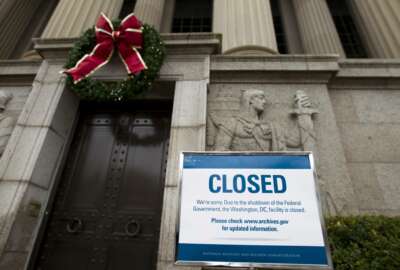
Agencies should restore annual leave lost due to government shutdown, OPM says
The Office of Personnel Management on Wednesday clarified that agencies should restore previously-scheduled annual leave lost in 2018 due to the government...
Though there’s still no end in sight to the partial government shutdown and many federal employees impacted by the lapse in appropriations won’t receive their scheduled paychecks on Friday, the Office of Personnel Management delivered some good news this week.
Agencies should restore any annual leave their employees lost at the end of 2018 due to the government shutdown, OPM clarified Wednesday.
“OPM and the Office of Management and Budget had determined, in guidance issued prior to the lapse, that a lapse in appropriation qualifies as an exigency of the public business for purposes of annual leave restoration,” Margaret Weichert, acting OPM director, said Wednesday in a memo. “Therefore, as long as the leave was properly scheduled in advance, agencies must restore any annual leave that was forfeited because of the lapse in appropriations — regardless of whether the affected employees were furloughed and excepted from the furlough.”
OPM said it received several questions about annual leave and the shutdown’s impact on employees’ leave banks.
Because all paid leave is canceled during a government shutdown, employees who had scheduled to take annual leave during the holidays had to forfeit the time.
Related Stories

A furloughed federal employee’s guide to filing for unemployment during the shutdown

Pay, leave and other questions answered ahead of Friday’s potential partial shutdown
For some, the government shutdown meant certain excepted employees not only had to cancel their leave and come into work but also exceed the annual leave ceiling.
The 2018 leave year ended on Jan. 5, 2019 for employees on the standard biweekly pay period cycle. Agencies can restore lost-leave scheduled before Jan. 5, as long as employees had requested to take that leave in writing before Nov. 24, 2018, according to OPM.
“Employing agencies are responsible for determining whether an employees met the advance scheduling requirement, based on OPM regulations and agency policies and procedures,” Weichert’s memo reads.
Employees can meet that requirement in multiple ways — either by email, a submission to their agency’s time and attendance system or scheduling a calendar request electronically.
As long as this partial government shutdown continues, federal employees can’t substitute annual leave for a furlough. The Antideficiency Act, which essentially bars government from spending money it doesn’t have, prohibits employees from taking paid time off.
But some federal employees told Federal News Network OPM’s guidance isn’t entirely helpful. They waited until after the Nov. 24 cutoff period to schedule their leave, because they wanted to see how many of their co-workers had requested off and what gaps in work they would need to fill during the holidays.
Others waited to schedule leave until later in the year — after President Donald Trump made the decision to declare Dec. 24 a federal holiday.
Shutdown impact on federal insurance?
While OPM has received many questions about annual leave, Federal News Network has received questions from readers about the status of their federal health insurance.
Enrollment in the Federal Employees Health Benefits Program (FEHBP) continues for up to one year in non-pay status. The government will continue to make its FEHBP contributions even during this shutdown, because OPM uses the Federal Employees Health Benefits Fund to make payments.
The enrollee share of FEHB premiums will accumulate and will be withheld from pay when the shutdown ends and employees return to work.
For participants who made changes to their health insurance during open season, those changes should have gone into effect Jan. 1 regardless of the current shutdown.
The National Active and Retired Federal Employees (NARFE) Association suggests FEHBP participants check with their new carriers to make sure they’re covered.
Enrollees in the Federal Employees Group Life Insurance program will continue to have coverage for up to a year in “non-pay” status.
Coverage under the Federal Long Term Care Insurance Partners will also continue. But if Long-Term Care Partners doesn’t receive premiums for three consecutive pay periods, it will begin to directly bill participants.
Enrollees in the Federal Employees Dental and Vision Program (FEDVIP) will continue to get coverage, but they may receive a bill if participants haven’t paid premiums for two consecutive pay periods.
“This essentially means the government would have to be shut down for a month before hearing from FEDVIP plans and be shut down for six weeks before hearing from Federal Long-Term Care Insurance Partners,” Jessica Klement, NARFE’s staff vice president for advocacy, told the association’s members during a shutdown webinar earlier this week.
Some agencies, such as the Justice Department, are updating their employees with additional information about their pay and benefits during the government shutdown. You can find Justice’s guidance here.
Copyright © 2024 Federal News Network. All rights reserved. This website is not intended for users located within the European Economic Area.
Nicole Ogrysko is a reporter for Federal News Network focusing on the federal workforce and federal pay and benefits.
Follow @nogryskoWFED



